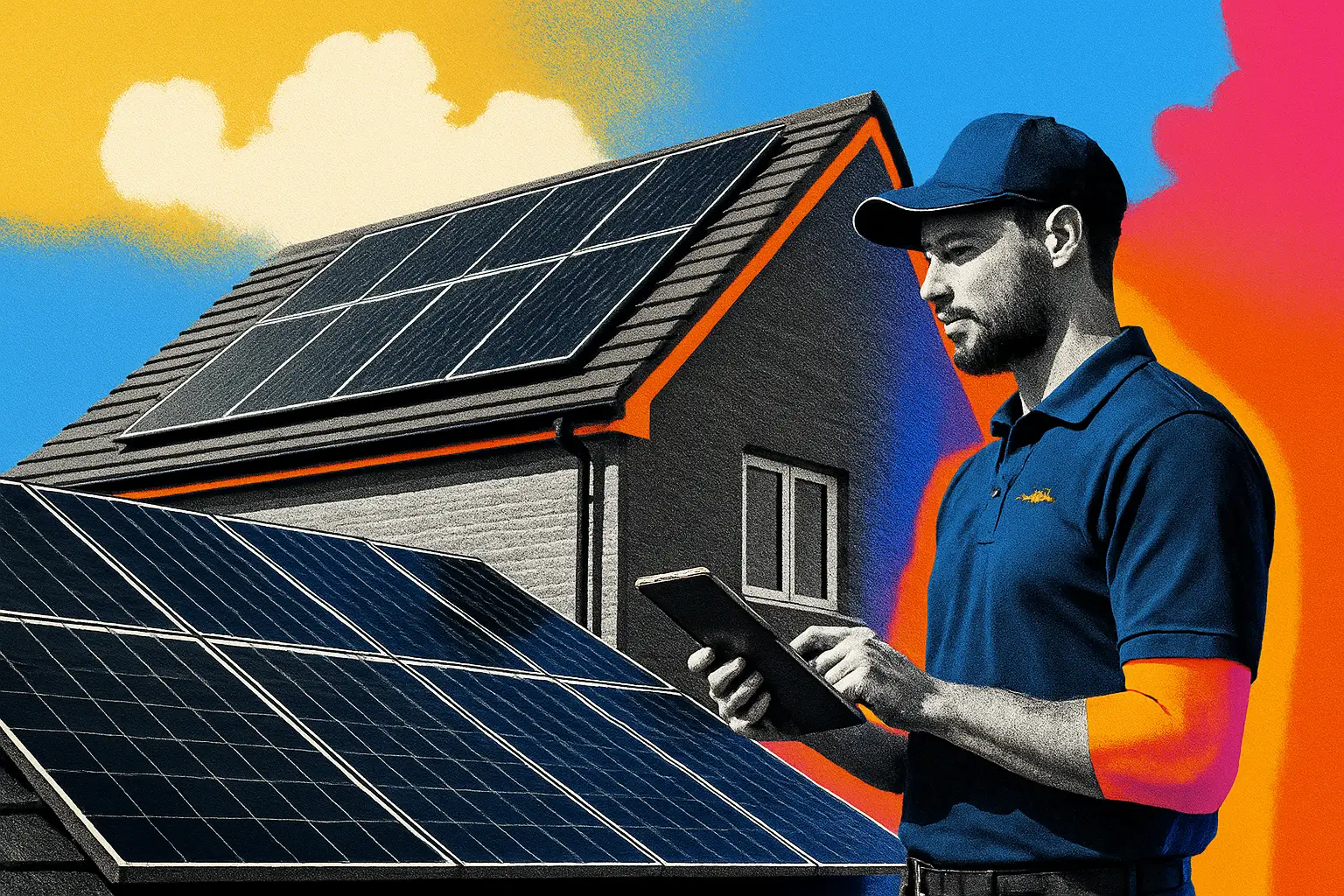Solar panels Home services: pros, cons & common pitfalls
UK solar is surging. Understand costs, returns, and pitfalls before you install. A practical guide to panels, batteries, incentives, and certified choices for British homes.
UK solar is booming - here is what matters now
The UK has entered a solar upswing. Domestic installations jumped 22% in the first half of 2025, with nearly 100,000 systems fitted, supported by the Government’s Solar Roadmap and stricter building standards. Record rooftop activity in early 2025 and strong adoption in Wales and Scotland underline a market maturing fast. This guide helps you make an informed, UK-specific decision.
Understanding payback is not just about tariffs - it is about designing a system that matches your home and lifestyle.
Who should consider solar right now
Solar can suit homeowners with a sunny roof, predictable daytime use, or smart tariffs. If you live in areas leading adoption - such as parts of Wales, Argyll and Bute, or The Cotswolds - local installer capacity may be strong. New-build buyers also benefit as 42% of new homes in England and around 80% in Scotland now include panels, pointing to long-term value and lower running costs.
Key terms made simple
- Solar PV: Photovoltaic panels that convert sunlight into electricity for your home.
- Inverter: Converts DC from panels to AC for household use.
- kW and kWh: kW is system power. kWh is energy used or generated.
- Export: Surplus electricity sent back to the grid under export tariffs.
- SEG tariff: Smart Export Guarantee - your supplier pays for exported units.
- Battery storage: Stores excess solar for evening or peak use.
- MCS certification: UK quality standard for products and installers. Required by most finance and export schemes.
- EPC rating: Energy Performance Certificate - higher ratings may improve property value and mortgage terms.
Why this matters now:
- Momentum: Q1 2025 recorded over 57,000 certified rooftop installs, the strongest since 2012, and March alone exceeded 21,000 alongside record solar generation of 12.7 GW in one day.
- Scale: UK installed solar capacity reached roughly 18 GW in 2025. Great Britain’s solar output rose 32% in early 2025 to a record 9.91 TWh.
- Policy: The Solar Roadmap and updated building regulations are pushing solar readiness and higher efficiency standards.
Your installation choices
Common home system configurations
| Option | Upfront cost | Typical payback | Best for | Export earnings |
|---|---|---|---|---|
| Grid-tied panels only | Lower | Shorter | Daytime users, smaller budgets | Yes via SEG |
| Panels + battery | Medium to higher | Mid-range | Evening users, higher self-consumption | Reduced exports, more self-use |
| Panels + battery + EV charger | Higher | Varies by usage | EV owners, time-of-use shifting | Flexible with smart tariffs |
| Off-grid setup | Highest | Long | Remote homes with limited grid access | Not applicable |
What is driving returns:
- Energy inflation protection: Generating your own power offsets grid rates.
- Smart tariffs: Pairing batteries with time-of-use plans can lower bills.
- Rising capacity: With over 2 GWp added in 2025 already, the market is scaling, improving product availability.
Regional notes:
- Wales leads several adoption hotspots, Scotland shows high new-build penetration, and England’s new homes are increasingly solar-ready due to Part L and the Future Homes Standard trajectory.
Money, savings and risks in context
- Costs: Typical UK domestic systems range from 3 kW to 6 kW. Panels-only installs are generally the most affordable. Batteries add flexibility and resilience but increase upfront spend.
- Returns: Depending on roof orientation, shading, tariff, and usage patterns, many homes target payback in 6 to 10 years for panels-only, longer if adding batteries. Higher self-consumption can sharpen savings.
- Export: The SEG pays for exported electricity. Rates differ by supplier and fluctuate. Accurate system sizing helps avoid over-reliance on variable export income.
- Market backdrop: Solar’s role is expanding, with solar reported as a major share of generation and 14.43 billion kWh expected in 2025 - enough to power millions of homes. This strengthens long-run consumer confidence.
- Risks: Supply chain constraints, installer availability, and regulatory complexity can delay projects or lift costs. Quality assurance via MCS reduces performance and warranty risks.
Standout point: Battery value is highest where evening use is strong or smart tariffs reward load shifting.
Are you likely to qualify
- Property type: Most houses with suitable roofs can install solar without planning permission under permitted development. Flats and listed buildings often require approvals.
- Roof suitability: South, south-east or south-west facing roofs with minimal shading are ideal. East or west works with modestly reduced yields.
- Electrical setup: Modern consumer units and space for an inverter and optional battery are needed. Some homes may require upgrades.
- Accreditation: To access SEG export payments and many finance products, use MCS-certified installers and equipment.
- New builds: Over 40% of new homes in England already include PV, and Scotland’s rates are higher. Owners of solar-ready homes may benefit from simpler upgrades and integrated warranties.
Tip: Request a shade analysis and generation forecast compliant with MCS guidelines before you sign.
From survey to switch-on - the simple path
- Initial suitability check and shade assessment
- MCS installer quote with itemised components
- Finance comparison and SEG export choice
- Technical survey and final design sign-off
- Installation, commissioning and safety checks
- DNO notification and MCS certificate issued
- Set up monitoring app and export registration
- Optimise tariffs and usage for best savings
Advantages and trade-offs
Pros:
- Lower bills and insulation from price volatility
- Potential property value uplift and improved EPC
- Access to SEG export income and smart tariffs
- Proven technology with strong UK rollout and support
Cons:
- Upfront cost, especially with batteries
- Output varies by season and weather
- Potential delays due to supply or permissions
- Poor installs can cut performance and void warranties
Balanced view: The strongest outcomes come from right-sizing, quality components, and credible installers.
Pitfalls to avoid before you commit
- Inadequate site assessment: Underestimating shade or roof constraints reduces yield.
- Overpromised payback: Ensure assumptions reflect your tariff, usage, and regional irradiation.
- Non-certified kit or installer: May block SEG access and complicate insurance or resale.
- Missing maintenance plan: Cleaning, periodic checks, and firmware updates protect output.
- Paperwork gaps: DNO notifications, warranties, and MCS documentation must be complete.
Choose an MCS-certified installer and keep all certificates - they underpin export payments and resale confidence.
If solar is not a fit today
- Insulation upgrades: Often the fastest, cheapest energy saver.
- Heat pumps: Combine well with solar and smart tariffs.
- Solar-ready wiring: Pre-cable for a future, lower-cost install.
- Community or shared solar: Explore local schemes if roof access is limited.
Comparison snapshot:
- Insulation: Lowest cost, immediate comfort gains.
- Solar PV: Medium cost, strong long-term savings.
- Battery alone: Storage without generation - depends on tariff arbitrage.
Quick answers to common questions
- How long do panels last? Many panels carry 20 to 25 year performance warranties. Inverters and batteries may need earlier replacement.
- What maintenance is needed? Occasional cleaning and annual visual checks. Monitoring apps help spot issues early.
- Do I need planning permission? Most homes do not. Listed buildings, flats, or conservation areas may need consent.
- What if I move house? Systems can boost EPC and buyer appeal. Transfer warranties and provide MCS and DNO paperwork.
- Are batteries worth it? Best where evening use is high or tariffs reward shifting. Panels-only often gives the fastest payback.
- Which tariffs are available? Suppliers offer SEG export and time-of-use rates. Shop around and review terms regularly.
Your next moves with Switcha
- Compare MCS-certified installers and like-for-like quotes
- Check SEG export rates and smart tariffs by supplier
- Ask for a documented yield forecast and payback range
- Validate warranties, finance terms, and installation timelines
Switcha can help you line up trusted quotes, verify certification, and choose tariffs that match your usage profile.
Small print you should know
This guide is general information for GB homeowners. It is not financial advice. System performance and savings vary by property, usage, tariffs, and equipment. Always use MCS-certified installers, review contracts carefully, and confirm planning and grid requirements with your local authority and DNO.
Get smarter with your money
Join thousands of people in the UK who are taking control of their financial future

FAQs
Common questions about managing your personal finances
Begin by tracking every expense for one month. Use an app or spreadsheet. No judgment. Just observe your spending patterns.
Cancel unused subscriptions. Cook at home. Compare utility providers. Small changes add up quickly.
Aim for 20% of your income. Start smaller if needed. Consistency matters more than the amount.
Choose reputable apps with strong security. Read reviews. Check privacy policies. Protect your financial data.
Pay bills on time. Keep credit card balances low. Check your credit report annually. Be patient.
Still have questions?
Our team is ready to help you navigate your financial journey
More financial insights
Explore our latest articles on personal finance and money management




